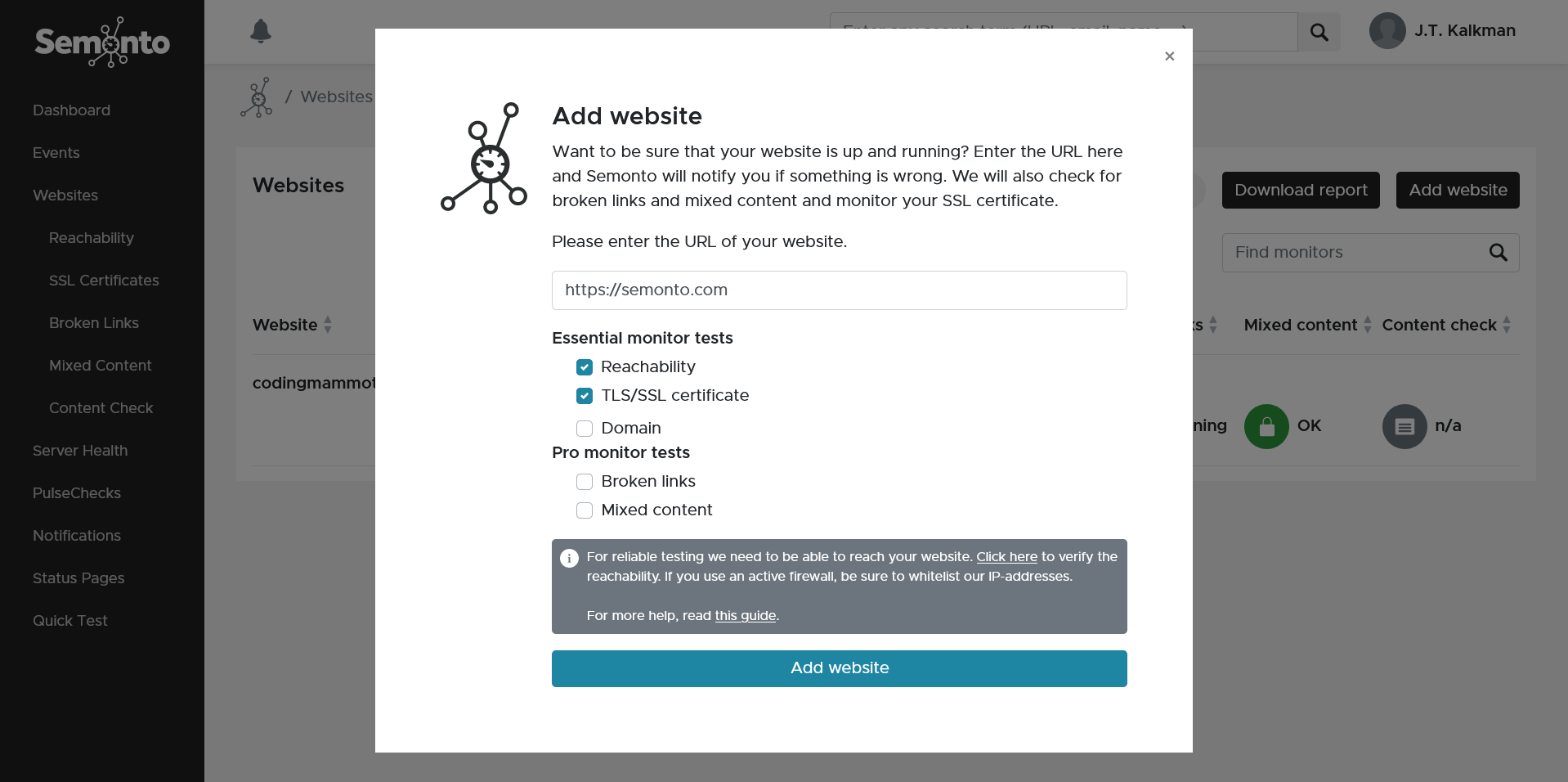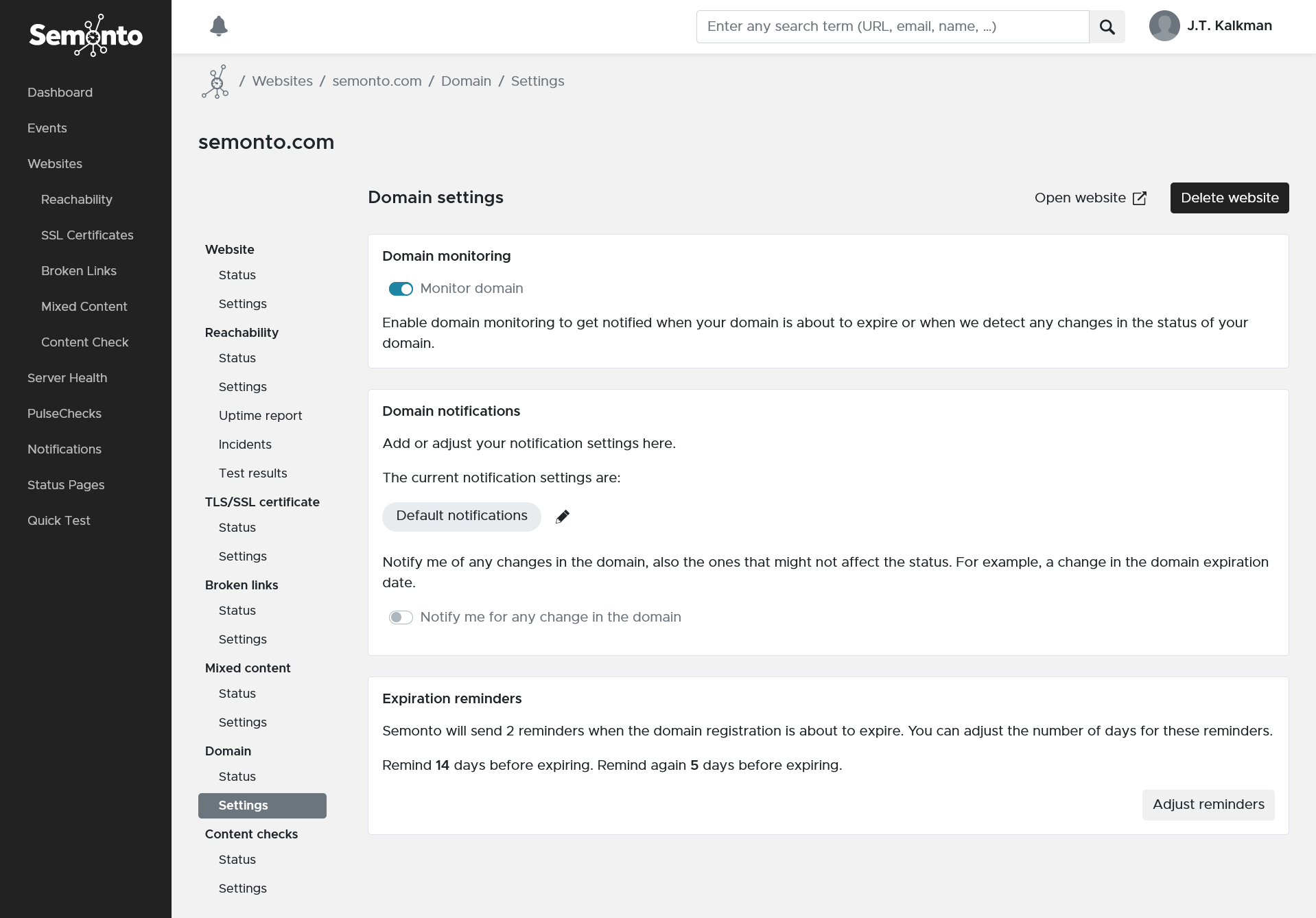How to monitor your domain using Semonto
In this manual, we show you how you can use monitoring tool Semonto to get notified when your domain is about to expire.

What is a domain?
Your domain is your address on the internet, usually made up of your company name followed by an extension like .com or .org. For example, Semonto’s domain is called Semonto.com. Your domain needs to be renewed regularly. If it expires, your domain is up for grabs. Anyone else can buy it. Imagine the damage this can do to your company.
The status of your domain

What is domain monitoring?
Domain monitoring is an automated way to check the expiration date and general status of your domain. When your domain is about to expire, the tool will notice it and let you know, so you can renew it in time. You also get informed of any other problems associated with your domain.
Why do you need to monitor your domain?
- Some domains are not automatically renewed
- Even automatic renewal can fail, for example if your credit card is rejected.
- If you forget to renew your domain, your website will become unreachable.
- Any with your domain associated e-mail services could also stop working.
- If your domain is not renewed, it can be hijacked by someone else.
- If your domain remains inaccessible, it harms your sales, SEO and reputation.
How to start monitoring your domain with Semonto
- Log into Semonto or create an account if you don’t have one.
- Select “add a website”.
- Enter the URL of the domain you want to monitor.
- Select “Domain” and click “Add website”.
- The domain will be added to your dashboard.

- Select the URL in the dashboard and go to Domain monitoring.
- There you can set your notification preferences: who should be notified and how.
- Semonto will start watching the status and expiration date.
- If your domain is about to expire, Semonto will warn you 14 days in advance and again 5 days in advance. You can adjust these reminders.
- Done! You can rest assured that no domain issues escape your attention.

How we monitor domains: using RDAP
To monitor domains, we consult a database that can be compared to an international phonebook, but for domains. This used to be called a WHOIS-search. This list is managed by non-profit organization IANA, using a protocol called RDAP: Registration Data Access Protocol. All domains are collected in this overview. When you activate domain monitoring, Semonto will access this database to retrieve the most recent information about your domain, like the expiry date, the registrar and the current status.
What is a TLD and why does it matter?
The part of your domain name following the dot (for example com, org or gov) is called the top-level domain or TLD. Some domains, for example the ones with TLD .be (Belgium) and .de (Germany), do not allow domain monitoring (yet). Here’s the list of TLDs that are supported.

FAQ
What if your domain can’t be monitored?
When you start monitoring a domain, you may see the message “This domain is not supported.” This usually isn’t a Semonto issue but a data limitation — for example, the domain may not have an RDAP record, or the registry doesn’t expose the information we need. You can read more about this here or check the list of supported domains.
What do the domain status codes mean?
Besides expiration date checks, Semonto also checks for the domain status codes. Below is a list of the possible status codes.
| EPP Status Code | inactive |
| RDAP Status Code | inactive |
| Info | The domain is not active. Contact your registrar for more information. |
| Status | Error |
| EPP Status Code | pendingDelete |
| RDAP Status Code | pending delete |
| Info | The domain will be deleted shortly. Contact the registrar to keep the domain. |
| Status | Error |
| EPP Status Code | pendingRestore |
| RDAP Status Code | pending restore |
| Info | The registrar has asked the registry to restore your domain. |
| Status | Error |
| EPP Status Code | redemptionPeriod |
| RDAP Status Code | redemption period |
| Info | The domain is in a 30-day buffer period before it gets deleted and becomes available for registration. Contact your registrar if you want to keep it. |
| Status | Error |
| EPP Status Code | serverHold |
| RDAP Status Code | server hold |
| Info | The domain is put on hold because something needs to be sorted out first. Contact your registrar for more information. |
| Status | Error |
| EPP Status Code | serverRenewProhibited |
| RDAP Status Code | server renew prohibited |
| Info | The registry will not allow the registrar to renew the domain. Contact the registrar if needed. |
| Status | Error |
| EPP Status Code | clientHold |
| RDAP Status Code | client hold |
| Info | The domain is put on hold because something needs to be sorted out first. Contact your registrar for more information. |
| Status | Error |
| EPP Status Code | addPeriod |
| RDAP Status Code | add period |
| Info | Grace period after the initial registration of the domain. There aren’t any issues. |
| Status | Warning |
| EPP Status Code | pendingTransfer |
| RDAP Status Code | pending transfer |
| Info | Someone has asked to move the domain to another registrar, and the transfer is in progress. |
| Status | Warning |
| EPP Status Code | pendingUpdate |
| RDAP Status Code | pending update |
| Info | A request has been made for an update to the domain, and it's currently being processed. |
| Status | Warning |
| EPP Status Code | transferPeriod |
| RDAP Status Code | transfer period |
| Info | Indicates a grace period after a domain is successfully transferred to another registrar. |
| Status | Warning |
| EPP Status Code | pendingCreate |
| RDAP Status Code | pending create |
| Info | A request has been made to create the domain, but it's not ready yet |
| Status | Warning |
| EPP Status Code | autoRenewPeriod |
| RDAP Status Code | auto renew period |
| Info | The domain has just been renewed automatically. |
| Status | OK |
| EPP Status Code | ok |
| RDAP Status Code | active |
| Info | The domain is up and running. There are no issues. |
| Status | OK |
| EPP Status Code | pendingRenew |
| RDAP Status Code | pending renew |
| Info | A request has been made to renew the domain, and it's currently being processed. |
| Status | OK |
| EPP Status Code | renewPeriod |
| RDAP Status Code | renew period |
| Info | The domain has expired, but there is a grace period during which it can still be renewed. Contact your registrar. |
| Status | OK |
| EPP Status Code | serverDeleteProhibited |
| RDAP Status Code | server delete prohibited |
| Info | The domain cannot be deleted. Contact your registrar for more information. |
| Status | OK |
| EPP Status Code | serverTransferProhibited |
| RDAP Status Code | server transfer prohibited |
| Info | Your domain cannot be transferred to another registrar right now. Contact your registrar for more information. |
| Status | OK |
| EPP Status Code | serverUpdateProhibited |
| RDAP Status Code | server update prohibited |
| Info | You cannot update this domain right now. Contact your registrar for more information. |
| Status | OK |
| EPP Status Code | clientDeleteProhibited |
| RDAP Status Code | client delete prohibited |
| Info | You cannot delete this domain right now. This status code is often used to prevent hijacking or fraud. |
| Status | OK |
| EPP Status Code | clientRenewProhibited |
| RDAP Status Code | client renew prohibited |
| Info | You cannot renew the domain right now. Contact your registrar for more information. |
| Status | OK |
| EPP Status Code | clientTransferProhibited |
| RDAP Status Code | client transfer prohibited |
| Info | You cannot transfer this domain to someone else right now. Contact your registrar for more information. |
| Status | OK |
| EPP Status Code | clientUpdateProhibited |
| RDAP Status Code | client update prohibited |
| Info | You cannot update this domain right now. Contact your registrar for more information. |
| Status | OK |
| RDAP Status Code | validated |
| Info | Signifies that the data of the object instance has been found to be accurate. This type of status is usually found on entity object instances to note the validity of identifying contact information. |
| Status | OK |
| RDAP Status Code | proxy |
| Info | The registration of the object instance has been performed by a third party. This is most commonly applied to entities. |
| Status | OK |
| RDAP Status Code | private |
| Info | The information of the object instance is not designated for public consumption. This is most commonly applied to entities. |
| Status | OK |
| RDAP Status Code | removed |
| Info | Some of the information of the object instance has not been made available and has been removed. This is most commonly applied to entities. |
| Status | OK |
| RDAP Status Code | obscured |
| Info | Some of the information of the object instance has been altered for the purposes of not readily revealing the actual information of the object instance. This is most commonly applied to entities. |
| Status | OK |
| RDAP Status Code | associated |
| Info | The object instance is associated with other object instances in the registry. This is most commonly used to signify that a nameserver is associated with a domain or that an entity is associated with a network resource or domain. |
| Status | OK |
| RDAP Status Code | locked |
| Info | Changes to the object instance cannot be made, including the association of other object instances. |
| Status | OK |
A complete description of these status codes can be found at icann.org
Let us know if you need any help!
Do not hesitate to reach out if you need any help getting started. We are more than happy to assist you.





